Classical Astronomy
Introduction
Astronomy is probably the oldest of sciences. Humans, with their innate curiosity and intelligence have looked up and wondered about phenomena in the sky since prehistoric times. People of different cultures scattered across the globe have incorporated their observations of celestial objects and events into their creation myths and religions. Civilizations such as the Babylonians and Egyptians made long-term, systematic observations of the night sky and some of their records still survive.
Five planets, Mercury, Venus, Mars, Jupiter and Saturn plus the Sun and Moon were visible to the unaided eyes of the ancient astronomers. The planets could be distinguished from stars in that through regular observation they were seen to move relative to the stars. The very word planet derives from the classical Greek term for wandering star. Unlike stars, planets also varied their brightness over time. A final complication in the observed behavior of planets was that of retrograde motion. This is where a planet seemed to back track on its path across the sky through the constellations before reverting to its normal direction. The diagram below clearly shows this for the planet Mars in late 2003.
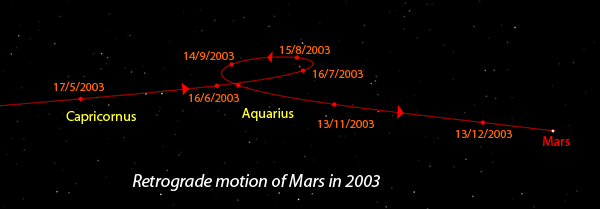
This section does not seek to provide a detailed history of astronomy up till Newton. If you wish to delve into this vast subject in more detail we encourage you to follow some of the links to other sites specialising in the topic. The depth presented here nonetheless probably goes beyond that required by the NSW syllabus. In doing so it should provide some background to what is a fascinating topic.
Classical Astronomers
The Ionians (6th - 4th Century BC)
The ancient Greeks, specifically the Ionian school of philosophers, are credited with the move to a natural, mechanistic view of the Universe. Based on Miletus in Asia Minor and founded by Thales, the Ionians are remembered not so much for the specific models of the Universe that they suggested, but rather that they asked questions that they could then attempt to answer through reason, observation and the application of geometry. Anaximander refined Thales' ideas and proposed a model which had a cylindrical Earth at rest in the centre of the Universe, surrounded by air then one or more spherical shells with holes in them. These appeared as stars due to the rim of fire that lay beyond the solid sphere.
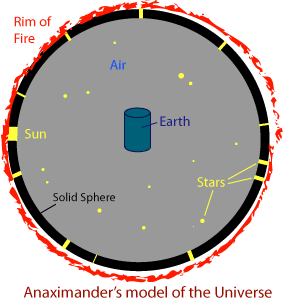
Anaximander's model of the Universe was revolutionary for two main reasons. Firstly it introduced a mechanistic view, moving beyond a mythological, supernatural explanation for the Universe. It also proposed the concept of spheres surrounding the Earth. This was to profoundly influence astronomy and cosmology for the next two millennia.Anaximenes refined Anaximander's model by suggesting that the stars were fixed on to a solid, transparent crystalline sphere that rotated about the Earth.
Later Ionians contributed more ideas and discoveries. Anaxogoras (c. 450 BC) realised that the Moon shone by reflected sunlight,had mountains and was inhabited and that the Sun was not a god but a large fiery stone much larger than Greece and a large distance from Earth. Empedocles suggested that light traveled fast but not at infinite speed. Democritus proposed not just at atomist model of matter but also proposed that the Milky Way was composed of thousands of unresolved stars.
The Pythagoreans

Pythagoras (c. 580 - 500 BC) is credited with postulating a spherical Earth and with realising that Phosphoros, the morning star and Hesperos, the evening star were in fact the same object, the planet Venus. He and his followers believed in the concept of cosmos, a well-ordered, harmonious Universe. They placed great importance on the power and aesthetics of geometry and mathematics rather than experiments. Regular geometrical solids, especially the sphere, were revered and they sought to find harmonies and ratios in the natural world.
Herakleides, a student of Plato and Aristotle but heavily influenced by Pythagorean ideas refined an earlier model by Philolaus to develop one that had a spherical Earth rotating on it axis. It also had Mercury and Venus revolving around the Sun whilst the Sun and other planets revolved around the Earth. Stars again were fixed on a revolving crystalline sphere. Models that had the Earth at the centre of the Universe are termed geocentric or earth-centered.
Interestingly whilst most classical models were variations on geocentric models, one of the Pythagoreans, Aristarchus of Samos (c. 310 - 230 BC) proposed a model that placed the Sun at the centre, that is a heliocentric Universe. His model would be familiar to us today as a reasonable description of the solar system. All the planets, including the earth, revolved around a fixed Sun in circular orbits. The Earth rotated once a day on its axis and the Moon revolved about the Earth.
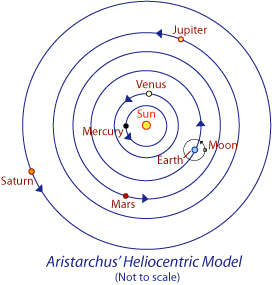
There are several reasons why Aristarchus' model did not gain wide acceptance and was in effect lost for 18 centuries until Copernicus redeveloped it. Firstly his original writings were lost in the destruction of the Great Library of Alexandria in AD 415. Secondly his concept of a moving Earth defies common sense. We do not feel the Earth spinning or moving through space. His idea contradicted the prevailing view of motion as espoused by Aristotle. The final key objection to his model was the failure of observers to detect any stellar parallax. Under Aristarchus' model, the closer stars should show a periodic shift in position to and fro against more distant stars over the course of a year as the Earth orbited the Sun. In fact this was not detected until 1838 following careful telescopic observations. Aristarchus had underestimated the distance of the earth from the Sun thus the size of possible parallax was overestimated.
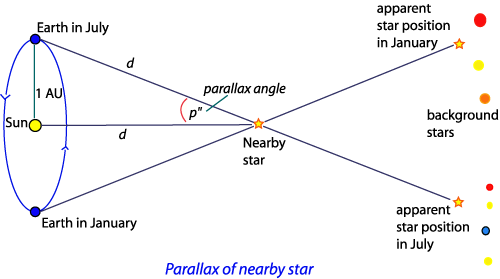
Plato (428 - 348 BC)

An Athenian and a pupil of Socrates, Plato had a profound influence on philosophy and he wrote widely on many different fields. Rather than being remembered for a specific model of the Universe it was his views on its nature, put forward in his dialogue Timaeus, that were to so strongly influence subsequent generations. To Plato the Universe was perfect and unchanging. Stars were eternal and divine, embedded in an outer sphere. All heavenly motions were circular or spherical as the sphere was the perfect shape. Such was his influence that the concept of circular paths was not challenged until Kepler, after many years of painstaking calculations, discovered the elliptical orbits of planets nearly 2,000 years later.
Plato thought that the visible world was only a dim representation of the real world. He was therefore not concerned with direct observations or how they correlated with his ideas but realised geometrical, arithmetical models could be devised to fit observations and save appearances.
Aristotle (384 - 322 BC)
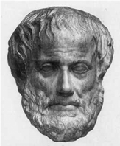
Aristotle's work had a profound influence on western thought, eventually being absorbed and molded into supporting Christian theology and dogma. He would probably have been disturbed by this. A pupil of Plato, he in turn tutored Alexander the Great. Whilst thought of as a theoretical philosopher he also conducted experiments in several fields. His works on astronomy and the physics of motion were written in On the heavens and Physics.
Like Empedocles before him Aristotle saw all matter on Earth as being composed of combinations of only four elements; earth, air, fire and water with the properties of cool, moist, hot and dry. The stars were made of a separate fifth element, quintessence and were incorruptible and eternal. Motion in the heavens was natural, unforced and circular so that the planets and Sun orbited a fixed, unmoving spherical Earth in circular orbits. On Earth, however, matter was corruptible and subject to decay. Motion was linear with objects requiring a force acting on them to stay in motion. It is was not until Newton in the second half of the seventeenth century that this concept of forced motion was overthrown.
Aristotle's own model of the Universe was a development of that of Eudoxus who had also studied under Plato. It had a series of 53 concentric, crystalline, transparent spheres rotating on different axes. Each sphere was centered on a stationary Earth so the model was both geocentric and homocentric. Stars were fixed on the outer sphere. The Moon marked the boundary between the unchanging, constant heavens and the corruptible Earth. According to Aristotelian cosmology it was only within the sub-lunary sphere, that is between the Earth and Moon, that changeable phenomena such as comets could exist.
Ptolemy (AD 120 - 180)
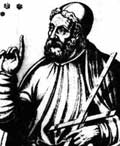
The last of the great classical astronomers, Claudius Ptolemy lived in Alexandria. He contributed to mathematics, optics, geography and music but is chiefly remembered for his vast work on astronomy, known as the Almagest. In it he detailed a model of the Universe that profoundly influenced Western and Arabic thought for the next 1,500 years.
Ptolemy relied heavily on tools invented and observations made by earlier astronomers. Apollonius (262 - 190 BC) had developed the concepts of the eccentric and the epicycle to explain planetary motions (see Figure 1.5 below). Hipparchus (161 - 126 BC) had organised earlier Babylonian records together with his own observations to develop a catalogue of 850 stars. He plotted them on a celestial sphere and introduced the concept of comparing brightnesses on a magnitude scale that forms the basis of that still used today. Ptolemy synthesised all this work and incorporated his own careful observations to produce a model that was to become accepted as the standard model until the 1600s.
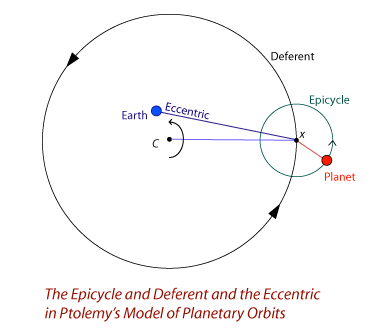
A planet orbits point x in a circular path called the epicycle. The deferent is the circular path that point x takes around the centre of motion, C. This is not the same point as the location of the Earth. The offset is called the eccentric. Different planets would have different eccentrics, deferents and epicycles. The resultant path traced out by a planet could account for retrograde motion and variations in brightness.
The Ptolemaic model had a spherical, unmoving Earth in the central region of the Universe, its natural place. Note contrary to common misconception, it was not strictly geocentric as the model used eccentrics; rather it was geostatic. 10,000 Earth diameters from the the centre, stars were fixed on a celestial sphere that rotated once every 24 hours. The Sun and the five planets had their motions explained by combinations of epicycles, deferents and eccentrics. In total some seventy circles and spheres were required.
Ptolemy's desire, inspired by Plato, that his model should fit observations and save appearances led him to introduce a subtle device, the equant, into his model. Each heavenly body had its own equant, the point around which motions of four epicycles appeared uniform. The equant did not coincide with the centre of a planet's deferent. Whilst the concept of the equant broke with the precept that the motion of spheres about their centres be uniform it was effective in accounting for the variations noted in the retrograde motion of some planets.
To us Ptolemy's model seems overly complex and clearly wrong yet it survived as the standard model used by scholars for 1,500 years. Why was this? There are several reasons:
- It worked, that is it could predict the position of a planet to within 2°.
- It accounted for the observed planetary motions, retrograde motion and variations in brightness.
- Unlike Aristarchus' model it did not predict the unobserved stellar parallax.
- It placed the Earth in its natural place at the centre of things, satisfying Aristotelian philosophy.
- It matched with common sense. We do not feel the Earth move and Ptolemy's model had a static Earth.
It was not seriously challenged until the mid-1500's by the work of Copernicus.
